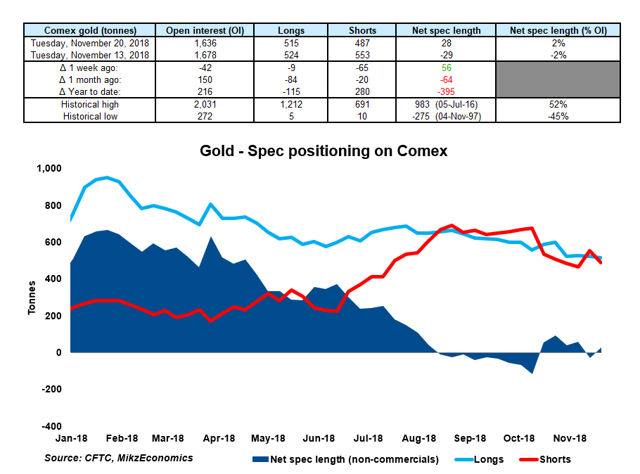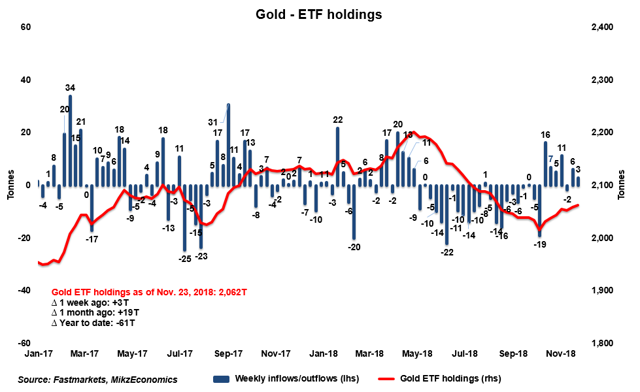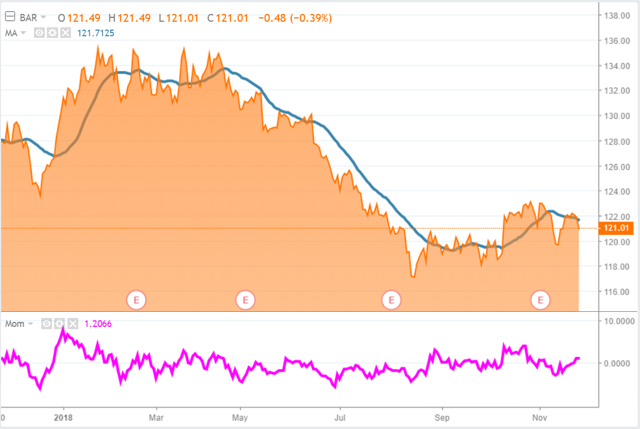Gold Weekly: The Speculative Community Has Less Conviction, Not Me!
Gold is stable since the start of November.
Speculators have a weaker conviction in gold prices, the CFTC shows.
ETF investors continue to accumulate gold, albeit at a small pace, according to Fastmarkets.
Despite a stronger dollar and higher US real rates, gold demand is positive due to higher vol in risk assets.
I expect gold prices to remain in an uptrend.

Conviction, Stella Kisstiger (Saatchi Art)
Introduction
Welcome to my Gold Weekly.
In this report, I wish to discuss mainly my views about the gold market through the GraniteShares Gold Trust ETF (BAR). BAR is directly impacted by the vagaries of gold spot prices because the fund physically holds gold bars in a London vault in the custody of ICBC Standard Bank.
To do so, I analyse the recent changes in speculative positions on the Comex (based on the CFTC) and ETF holdings (based on FastMarkets' estimates) in a bid to draw some interpretations about investor and speculator behavior. Then, I discuss my global macro view and the implications for monetary demand for gold. I conclude the report by sharing my trading positioning.
Speculative positions on the Comex
The CFTC statistics are public and free. The CFTC publishes its Commitment of Traders report (COTR) every Friday, which covers data from the week ending the previous Tuesday. In this COTR, I analyze the speculative positioning, that is, the positions held by the speculative community, called "non-commercials" in the legacy COTR, which tracks data from 1986.
It is important to note that the changes in speculative positioning in the gold futures contracts do not involve physical flows because it is very uncommon for speculators to take delivery of physical on the futures contracts that they trade. Due to the use of leverage by speculators, the changes in speculative positions in gold futures contracts tend to be much greater than the changes in other components of gold demand like ETFs or jewellery.
As a result, the impact on gold spot prices tends to be relatively more important and volatile, which, in turn, affect the value of BAR because the latter physically holds the metal in vaults in London and, therefore, has a direct exposure to spot gold prices.
Gold ETF positions
The data about gold ETF holdings are from FastMarkets, an independent metals agency which tracks ETF holdings across the precious metals complex. FastMarkets tracks on a daily basis a total of 21 gold ETFs, which represent the majority of total gold ETF holdings. The largest gold ETFs tracked by FastMarkets are the SPDR (R) Gold Shares (GLD), whose holdings represent nearly 40% of total gold ETF holdings, and the iShares Gold Trust (IAU), whose holdings represent roughly 15% of total gold ETF holdings.
Speculative positioning
Source: CFTC
According to the latest Commitment of Traders report (COTR) provided by the CFTC, non-commercials switched to a net long position in Comex gold in the week to November 20.
The net spec length increased by 56 tonnes, moving from -29 tonnes (-2% of open interest) on November 13 to +28 tonnes (+2% of open interest) on November 20.
The improvement in gold's spec positioning was exclusively owing to short-covering (-65 tonnes), partly offset by long liquidation (-9 tonnes).
Both gross longs (light blue line) and shorts (red line) have trended lower since August. This signals a weaker conviction in the future price direction of gold prices among the speculative community.
Judging by historical standards, it is clear that the current net spec length is too low and, therefore, is due to rise eventually.
Against this, I expect shorts to continue to unwind their positions, resulting in further upward pressure in gold prices. Once the rebound from the 2018 low of $1,160 per oz looks sustainable (e.g., a break above the 200 daily moving average), I expect longs to become more confident to rebuild some positioning.
Bottom line: The current spec positioning in Comex gold is abnormally weak, judging by historical standards. Over a 12-month window, I expect a normalization (short-covering + fresh buying) in Comex gold's spec positioning, pushing Comex spot gold prices higher. In turn, the value of GraniteShares Gold Trust ETF will increase.
Investment positioning
Source: Fastmarkets
ETF investors lifted their gold holdings in the week to November 23, according to FastMarkets.
Gold ETF holdings rose a small 3 tonnes over November 16-23, almost exclusively the result of GLD inflows. This marked a sixth time of inflows over the past 7 weeks.
ETF investors have bought around 19 tonnes of gold over the past month, pointing to a renewed appetite for the yellow metal.
The current macro environment is conducive to incremental investor flows into gold, due to an increased level of risk-aversion stemming from a rising yield environment. Although the Fed seems confident that it will "gradually" raise rates in 2019, risk assets have already started to feel the pinch from the gradual monetary policy normalization.
The fact that investors have continued to accumulate gold despite a stronger dollar and higher US real rates is a bullish signal because it shows that gold is increasingly viewed as a key asset in investors' portfolios in order to be hedged against any kind of tail risk.
Bottom line: ETF inflows into gold should remain steady in the coming weeks as a result of a gradual increase in volatility in risk assets, notwithstanding an appreciation in the greenback and a rise in US real rates.
Trading positioning
To assert upside exposure to gold prices, I have a long position in the GraniteShares Gold Trust ETF.
Source: Seeking Alpha
BAR's technical indicators are not bullish. Although the momentum is back in positive territory, the 20 daily moving average is downwardly sloping and BAR remains below its 20 DMA, thereby reflecting a fragile sentiment.
That said, I continue to work under the hypothesis that the worst is over: namely, the 2018 low is behind us.
Bottom line: The risk-reward is betting for holding a long position in the long term. Ergo, I remain long BAR.
BAR - GraniteShares - Review
BAR is directly impacted by the vagaries of gold spot prices because the fund physically holds gold bars in a London vault and custodied by ICBC Standard Bank. The investment objective of the fund is to replicate the performance of the price of gold, less trust expenses (0.20%), according to BAR's prospectus.
The physically-backed methodology prevents investors from getting hurt by the contango structure of the gold market, contrary to ETFs using futures contracts.
Also, the structure of a grantor trust protects investors since trustees cannot lend the gold bars.
BAR provides exposure which is identical to established competitors like GLD and IAU, which are nevertheless much more costly to hold over a long period of time. Indeed, BAR offers an expense ratio of just 0.20% while GLD and IAU have an expense ratio of 0.25% and 0.50%, respectively.
As of November 26, BAR traded at a slight discount of $0.09 per share to its net asset value, compared with a premium of $0.25 per share ten days ago. I expect any deviation from the net asset value to narrow on the back of arbitrage opportunities, which should offer an extra yield to BAR investors.
BAR's average spread (over the past 60 trading days) is 0.02%, which is lower than that of its competitor IAU, at 0.09%, or SPDR Gold MiniShares Trust (GLDM), at 0.08%.
As a result, BAR offers the lowest total cost of ownership (expense ratio + spread) among gold ETFs.
BAR's average daily volume (over the past 45 trading days) is ~$2 million, which is much lower than that of IAU, at ~$126 million.
As of November 26, 2018, BAR's assets under management (AUM) totaled $288 million, with 2.4 million shares. BAR's gold holdings were at 7.3 tonnes. In contrast, IAU's assets under management amounted to $10.7 billion, with 911 million shares. IAU's gold holdings were at around 271 tonnes.
For the sake of transparency, I will update my trading activity on my Twitter account.
Final note
Dear friends, if you enjoy reading my research, thank you for showing your support by clicking the "Follow" orange button beside my name on the top of the page and sharing/liking this article. I look forward to reading your comments below.
Disclosure: I am/we are long BAR.
I wrote this article myself, and it expresses my own opinions. I am not receiving compensation for it (other than from Seeking Alpha). I have no business relationship with any company whose stock is mentioned in this article.
Follow Boris Mikanikrezai and get email alerts

